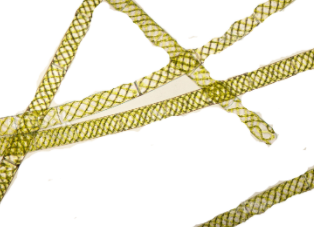
Pyrenoid is found in which one of the following organs on Spirogyra.
A. Nucleolus
B. Cytoplasm
C. Chloroplast
D. Vacuole.
Answer
474.3k+ views
Hint:Pyrenoids are subcellular microcompartments which are found in the chloroplasts of many algae. Pyrenoids probably function to fix carbon.
Complete answer:
To answer this question, first, we need to know about the Spirogyra. Spirogyras are filamentous algae that consist of thin unbranched chains of cylindrical cells. They can form masses that float near the surface of streams and ponds, buoyed by oxygen bubbles released during photosynthesis. Every cell of the filaments consists of a huge centre vacuole, within which the nucleus is suspended by fine strands of cytoplasm. The chloroplasts form a spiral around the vacuole and have specialized bodies known as pyrenoids that store starch. The cell wall consists of an inner layer of cellulose and an outer layer of pectin, which is responsible for the slippery texture of the algae.

Fig – Spirogyra.
Now, let us find the solution from the option.
Pyrenoids occur in many of the algae and are associated with the chloroplasts. Some of them are known to contain Rubisco, the enzyme that catalyzes the incorporation of inorganic $CO_2$ into carbohydrates. In these algae, pyrenoids probably function to fix carbon. In a few algae, the pyrenoids are the regions of carbohydrate (usually starch) storing. Starch and iodine act to develop a dense blue-black colour, thus the staining a thin algal fix with iodine will determine the availability of pyrenoids.
Spirogyra is a filament consisting algae with green colour where the chloroplast has a feature of coil form. The numerous small spherical blobs along with the corners of the chloroplast are known as the pyrenoids. The larger, faint blobs (they look like out-of-focus regions) that take up most of the volume of the cells in the filaments on the right are the nuclei, which are suspended in the interior of the cells.
Thus, the correct option is C. i.e. Chloroplast.
Note:The pyrenoid is a concentrated structure internally or externally chloroplasts of some algae, includes widely of ribulose bisphosphate carboxylase enzymes which is important in photosynthesis process for carbon fixation and in this way sugar produced. Starch, a storage form of glucose, is often found around pyrenoids. Starch and iodine react to produce a deep blue- black color, so staining a thin algal preparation with iodine will indicate the presence of pyrenoids.
Complete answer:
To answer this question, first, we need to know about the Spirogyra. Spirogyras are filamentous algae that consist of thin unbranched chains of cylindrical cells. They can form masses that float near the surface of streams and ponds, buoyed by oxygen bubbles released during photosynthesis. Every cell of the filaments consists of a huge centre vacuole, within which the nucleus is suspended by fine strands of cytoplasm. The chloroplasts form a spiral around the vacuole and have specialized bodies known as pyrenoids that store starch. The cell wall consists of an inner layer of cellulose and an outer layer of pectin, which is responsible for the slippery texture of the algae.

Fig – Spirogyra.
Now, let us find the solution from the option.
Pyrenoids occur in many of the algae and are associated with the chloroplasts. Some of them are known to contain Rubisco, the enzyme that catalyzes the incorporation of inorganic $CO_2$ into carbohydrates. In these algae, pyrenoids probably function to fix carbon. In a few algae, the pyrenoids are the regions of carbohydrate (usually starch) storing. Starch and iodine act to develop a dense blue-black colour, thus the staining a thin algal fix with iodine will determine the availability of pyrenoids.
Spirogyra is a filament consisting algae with green colour where the chloroplast has a feature of coil form. The numerous small spherical blobs along with the corners of the chloroplast are known as the pyrenoids. The larger, faint blobs (they look like out-of-focus regions) that take up most of the volume of the cells in the filaments on the right are the nuclei, which are suspended in the interior of the cells.
Thus, the correct option is C. i.e. Chloroplast.
Note:The pyrenoid is a concentrated structure internally or externally chloroplasts of some algae, includes widely of ribulose bisphosphate carboxylase enzymes which is important in photosynthesis process for carbon fixation and in this way sugar produced. Starch, a storage form of glucose, is often found around pyrenoids. Starch and iodine react to produce a deep blue- black color, so staining a thin algal preparation with iodine will indicate the presence of pyrenoids.
Recently Updated Pages
Master Class 11 Accountancy: Engaging Questions & Answers for Success

Glucose when reduced with HI and red Phosphorus gives class 11 chemistry CBSE

The highest possible oxidation states of Uranium and class 11 chemistry CBSE

Find the value of x if the mode of the following data class 11 maths CBSE

Which of the following can be used in the Friedel Crafts class 11 chemistry CBSE

A sphere of mass 40 kg is attracted by a second sphere class 11 physics CBSE

Trending doubts
10 examples of friction in our daily life

One Metric ton is equal to kg A 10000 B 1000 C 100 class 11 physics CBSE

Difference Between Prokaryotic Cells and Eukaryotic Cells

State and prove Bernoullis theorem class 11 physics CBSE

What organs are located on the left side of your body class 11 biology CBSE

How many valence electrons does nitrogen have class 11 chemistry CBSE




